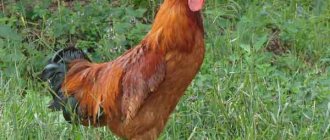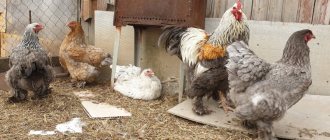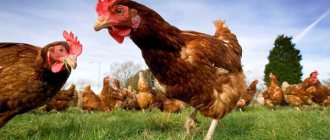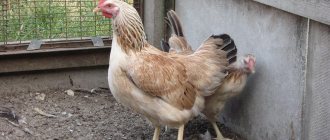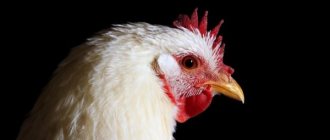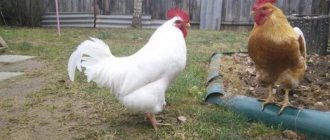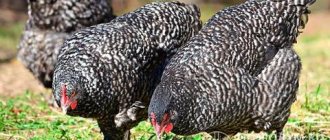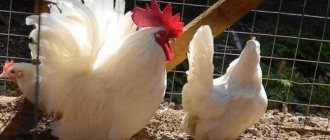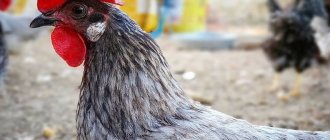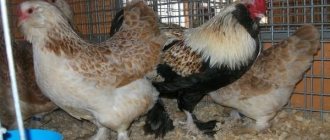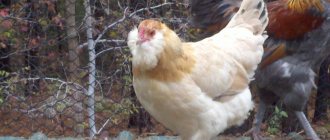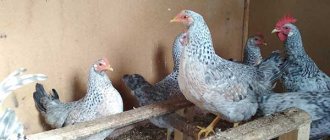Leghorn chickens are a highly productive egg-producing breed, the bird was bred in Italy. Today it is the basis of most egg-laying crosses and is actively used in poultry farming.
More than 20 varieties of the breed are known, differing in plumage color and productivity. Despite the long existence of the breed, Leghorns are still being improved today, and new species lines are appearing. From the article you will learn what is remarkable about the breed and the features of its breeding.
Description of the breed
Photo:
Leghorn chickens are unpretentious, so they can be found even in the coldest corners of the world.
Externally, these are large birds with the following characteristics:
- proportional wedge-shaped body;
- a thin and long neck on which is a small head;
- the comb is leaf-shaped, painted in a bright red hue. In roosters it is straight, in chickens it hangs to the side;
- the legs are long, in young birds they have a yellowish tint, turning white as the bird grows older;
- earlobes are white or blue, earrings are always red;
- the back is curved, the chest is convex;
- the eyes are small, the iris is yellow, orange or light brown;
- in chicks the skin is slightly yellow, in adults it is flesh-colored.
More than 20 colors of Leghorn plumage have been bred, but white birds are the most popular. Brown, partridge, motley and even black are also found on private plots. The birds have a calm, phlegmatic character and get along well with other inhabitants of the farm.
Origin story
Leghorn is a breed of Italian origin. They received their name only towards the end of the 20th century after productive chickens were brought to America.
It is believed that Leghorn comes from the word Livorno, the name of a large Italian port. After the active spread of the bird, work began on its selection; chickens were crossed with Minorcas and Japanese ornamental roosters.
It was then that Leghorn chickens received their signature white plumage. Birds arrived in Russia only in 1925, and chickens began to be bred on an industrial scale only in the 70s.
Today, the Leghorn breed is one of the most common breeds of egg-laying chickens in the world.
Price
The cost of roosters of this breed varies between 200-250 rubles. Growing chickens can be purchased for 150-180 rubles/piece. Laying hens are more expensive, their cost is 300-350 rubles. Leghorn chickens (by description and photo you can study the exterior of the subspecies) are considered the most popular breed of egg production. When buying a bird, you need to pay attention to its appearance: males and females should have dense plumage, uniform color and a strong beak. Healthy individuals have shiny eyes, without signs of clouding or inflammation of the sclera.
Varieties
It is believed that Leghorns today are no longer an independent breed, but a kind of genetic base for the formation of new species. In each country, active work is underway to develop new egg crosses and varieties of the breed.
There are more than 20 breeding factories operating in Russia alone. Only white and dwarf leghorns are the most popular.
White
The key species of the breed differs from other varieties in the snow-white color of its plumage; other colors on the body are a defect from the standard.
The bird does not lose productivity even under unfavorable conditions and can withstand severe frosts. It was white chickens that gave rise to all the other 20 shades of plumage, which is associated with an increase in demand for brown shells and the decorative appearance of birds.
Brown
They also have an egg production orientation and are distinguished by a beautiful golden-brown plumage color. They have pronounced sexual dimorphism; roosters can be distinguished not only by size, but also by the presence of long red-gold feathers on the neck.
It is acceptable to have black plumage, which in the sun has a green tint.
Cuckoo-partridges
This variety is often used for genetic work. Birds are highly adaptable and unpretentious in maintenance.
Unlike other species, Leghorns with this color are larger and can grow up to 4 kg. Chickens lay smaller eggs, but egg production is at a high level.
Golden
One of the most beautiful varieties of the breed. The plumage is painted in a rich golden color, the comb and earrings are red, and the earlobes are yellow. They are used only as ornamental birds, but egg production can reach 260 eggs per year.
Dwarf
This subspecies of the breed is called B-33. The weight of a rooster can reach only 1.7 kg, chickens are slightly less. Adults have white plumage, chicks are always yellow. The dwarf variety of the breed has an energetic temperament but is not aggressive towards other birds on the farm.
They are economical to maintain and are a real decoration of the site. But even among dwarf leghorns, egg production indicators are at the same level - a laying hen lays up to 250 eggs per year.
Where is it better to keep: in a cage or on a walk?
Chickens are active and emotional, and due to stress they stop egg production for 10-14 days. It is recommended to keep Leghorns in a barn with a walk that has a partial roof. Due to the ability of chickens to fly and the desire to develop a new territory, the height of the fence for their walking is needed 150 cm, and optimally 200 cm. Cage housing is allowed for industrial breeding of poultry, when it is used for several months, and egg production is stimulated by premixes. For a homestead, this method of maintenance is undesirable. When kept in cages, Leghorn-based hybrids are chosen.
The bird is not aggressive towards humans. Roosters may attack their owner if they perceive him as a threat to the hens, and usually limit themselves to intimidation. Aggression between chickens occurs extremely rarely and is rather the exception. Leghorns are quite tolerant of other breeds of chickens. May be kept with other poultry.
Price
The cost of young birds depends on the region, farm, and the color of the bird’s plumage. On average, the price for laying hens is 500 rubles, roosters are more expensive - from 700 rubles.
Hatching eggs are cheaper, the price tag starts from 75 rubles. The breed has a high hatchability rate, but before purchasing eggs, you must check them with an ovoscope for defects.
Reviews
Leghorn chickens have received the most positive reviews from poultry farmers. The breed is distinguished by high levels of egg productivity, unpretentiousness and adaptability to living conditions.
Birds are actively used on industrial and private farms as genetic material for breeding new highly productive crosses.
Among the disadvantages are the lack of brooding instinct and the high price of high-quality young animals. It should be remembered that in the second year egg production decreases, so the population of laying hens should be updated in a timely manner.
Character
Leghorns are very active, they need a lot of space and the opportunity to spend time walking. But if necessary, they can be kept in spacious cages. Females are shy and prone to stress. Males have a loud, sonorous voice. Tolerant of other breeds that are not prone to aggression.
Hatching instinct
During the selection of the breed, chickens completely lost their maternal instinct. With a high productivity of eggs, most of which are fertilized thanks to active males, the use of females as brood hens is excluded. Chickens are hatched in incubators, but eggs can be placed with hens of other breeds that are tolerant of hatching foreign eggs. The embryos are viable, hatchability reaches 92%, and the chickens are in good health.
Productivity, egg production
Beginning in the late 19th century, selection for Leghorns was carried out to increase egg production and reach sexual maturity earlier. On average, roosters weigh 2.5-2.7 kg, chickens weigh less - up to 1.9 kg.
The meat of this breed is not of high quality, it is very dry and bony. Egg production is one of the highest among purebred breeds; the annual number of eggs varies from 160 to 300 depending on the age of the bird and conditions of detention.
The weight of the egg reaches 65 g, the shell is very strong and white. Oviposition begins at 17-18 weeks of life, and from the second year the indicators gradually decrease.
Breeding
Laying hens of the Leghorn breed completely lack the brooding instinct, so for breeding you need to purchase raised young animals or use hatching eggs.
Chickens have a high survival rate and have strong immunity. If you plan to raise young birds yourself, then you need to prepare a brooder - a room for keeping birds in the first weeks of life.
For a small herd, a box or enclosure equipped with a heat source and lighting is suitable.
Photos
In the following photo you can see several individuals of both roosters and laying hens of the White Leghorn breed in one of the farms:
Photo of a white Leghorn hen in hand:
A beautiful specimen of a rooster walking in the garden:
There is already a larger farm here. The chickens seemed to come to take photos:
Male and female Partridge Leghorn, or as it is also called “Italian Partridge”:
Specifics of maintenance and care
The White Leghorn is distinguished by its unpretentiousness, adaptability and ability to acclimatize to almost any living conditions.
It is permissible to raise birds using the floor or cage method; in a small yard it is recommended to equip a spacious walking area.
On industrial farms, Leghorns are raised only in cages, which increases the risk of developing diseases. To avoid outbreaks of infection, vaccinations are carried out and antibiotics are added to the feed.
The requirements for keeping this breed are the same as for other representatives of the egg-producing type.
An important requirement is to limit noise, since during the period of active egg laying, laying hens are very anxious and afraid of any loud sounds. This leads to attacks of hysteria, and the birds' productivity is significantly reduced.
Regardless of the method of keeping, the entire flock should be provided with sufficient space; usually the chicken coop is planned at the rate of 3-4 individuals per 1 m2.
It is necessary to have drinking trays (100x120 mm), as well as several feeders. For birds, you need to equip perches for sleeping and nests for laying hens. The maximum humidity in the room should not exceed 70%, the optimal temperature is 12-16°C.
Are Leghorn laying hens profitable in Russia?
As practice shows, leghorns, in fact, in each country, the breed is represented by several intra-breed types, ... lay equally well and show excellent results in private households, and on small farms, and in industrial poultry farms.
From a commercial point of view, the characteristics of Leghorn chickens. In fact, in each country the breed is represented by several intra-breed types, ... is simply ideal: they eat little, lay eggs very well, and do not require any extra special conditions or feed. Thus, the question of the profitability of leghorn breeding depends only on the ability to organize sales of products, since there are no problems with achieving the optimal cost of production.
However, it should be taken into account that the meat yield from Leghorn chickens. In fact, in each country the breed is represented by several intra-breed types, ... absolutely minimal. In large-scale production, this is not a particular problem, since small Leghorn carcasses can be processed for the production of the same dog food. But for a private household, where they want to get not only eggs from chickens, but also a reasonable amount of meat, Leghorns, in fact, in each country the breed is represented by several intra-breed types, ... may not be the optimal option. However, to obtain meat at home, you can always use, along with Leghorns, also meat broilers, or simply a meat breed.
Feeding
There are no special feeding requirements for Leghorns. Chickens of this breed have a poor appetite, which allows them to save on feeding. However, you should be careful about the quality of food.
To maintain a high level of egg production, usually only feed is used that contains all the necessary components.
It is recommended to diversify the diet with fresh herbs in summer, vegetables and straw in winter. Every day you need to add chalk, slaked lime and shellfish to the food to form the shell. To maintain egg production, hens are also given vitamin supplements and high protein foods.
The average daily amount of feed should be 65-75 g per bird; food is best divided into two meals. In addition, there should always be sufficient fresh water in the chicken coop.
Chickens up to 14 days of age are kept in a separate room, gradually transferring them to an adult diet. To avoid problems with egg production, from the 6th day onwards, chicks should be offered shellfish, feed chalk or crushed shells. The diet of chicks is the same as for other breeds.
Features of cultivation
Leghorn chickens can be raised in any suitable area. At the same time, the birds will not behave at least a little capriciously. They can perfectly adapt even to cool climate zones. Leghorn chickens eat sparingly, which saves money on their maintenance, and also freely adapt to various natural conditions.
They can withstand frosts similarly, they can walk in the snow, and at the same time there is no need to worry about frostbite on their paws, beards and combs. Such cases are quite rare and only at extremely low temperatures. They also will not require special food. However, you should not feed them poor quality food.
In order to promote early maturity of the breed, chickens need to be given eggs, wheat bran and grain, vegetables, herbs, bone meal, and then transferred to a special feed. For proper egg production, it is necessary to give laying hens protein foods and vitamin supplements. As for the pen, then the birds can be kept in a cage, but they must be regularly released into the most spacious pen to avoid the formation of various diseases.
Conditions of detention
Leghorns can live in any conditions, in villages, on farms and in summer cottages - these are ordinary chicken coops, with areas for roosting, drinking bowls, feeders, sand or sawdust on the floor, and in industries - these are usually cages.
It goes without saying that the less space, the less productivity; industrial chickens lay eggs for no more than a year, and then become completely exhausted, even despite constant feeding with medicines. Therefore, for home rearing, it is still better to keep them in a chicken coop rather than in cages, this way they will have more freedom, greater immunity and, accordingly, better productivity.
It is also advisable to have a space for walking, small or large does not matter, the most important thing is that it is illuminated by the sun, and grass grows on it, the earth is a kind of small field. Unlike most other types of Leghorn chickens, they are not at all curious and will not go into the garden unnecessarily, of course, unless you give them unhindered access there.
So you don’t have to worry about your crops and seedlings. Preventative treatment of the chicken coop should be performed at least once a year in order to protect chickens and eggs from possible diseases. And cleaning the chicken coop should be done as it gets dirty.
Feeding the chickens
Leghorn chickens eat little, but to maintain high productivity the feed must be balanced.
The diet consists of 3 meals:
- in the evening and in the morning - grain crops (barley and wheat);
- for lunch - mash with the addition of root vegetables, fruits and herbs.
For good development, Leghorns must have mineral and vitamin supplements, salt, lime and chalk in their diet. The digestion process is accelerated by the presence of crushed shell rock. In summer, greens, which are constantly given, will be a significant source of nutrients; in winter, when the bird feels a deficiency of vitamins, grass meal or dried grass, previously harvested in the summer, should be added to the mash.
We should not forget about clean water, which should always be freely available to birds. Warm water in the cold season has a positive effect on the development of eggs.
Breeding Features
It will not be possible to make hens from Leghorns, since the maternal instinct was eliminated in the selection process almost purposefully. The hen stops the fertile period during hatching, which is economically unprofitable. Therefore, the creators of the breed rejected laying hens during the breeding process that tried to sit on eggs. Imperceptibly, the instinct of hens among Leghorns was completely eliminated.
To raise the breed, Leghorn eggs are placed under other hens or placed in an incubator. Smooth, defect-free eggs are selected for placement in the incubator. Chicks are usually born after 27–28 days.
The hatchability of chicks is 90–92%, survival rate is 95%. Immediately after hatching, the temperature level of the chicks should be 30–35 degrees Celsius. Gradually the temperature drops and by the age of one month it reaches 19–20.
For the first five days, chickens are fed semolina and boiled eggs. Gradually, chopped green onions, boiled vegetables, crushed grains, and cottage cheese are added to the menu. 2 weeks after birth, the chicks are given a mash of cereals, herbs and vegetables. Every day they add cottage cheese, fish oil, and vitamin and mineral complexes. Additives from fish and bone meal, shell rock, and chalk are used as a source.
The number of feedings up to a month is from 6 to 4 times a day. From the age of one month, the bird is fed three times.
Disease Control
On large farms there is constant noise, which has a detrimental effect on the health of laying hens. Over time, this can lead to a disease such as noise hysteria. The symptoms are as follows: high aggressiveness towards each other, frequent fights. As a result, the chickens lose their plumage and stop laying eggs. If acceptable conditions are not created in time, then the attacks will become more frequent and lead to death.
Judging by the numerous reviews from local farmers, one can judge the advantages of this breed of chicken. They are usually bred by those who aim to obtain an impressive number of eggs. At the same time, the birds are compact, consume less feed and do not require special care.
Diseases and their treatment
In general, Leghorns are a disease-resistant breed. In crowded housing or regular exposure to noise, laying hens may experience attacks of mass noise hysteria. The birds begin to scream heart-rendingly, hit the walls, and attacks of causeless aggression occur. This leads to injuries from the sharp corners of the cages, injury to the limbs and decreased productivity.
Adult chickens often have problems with the oviduct - it becomes inflamed and falls out (salpingitis). As a rule, this pathology develops starting from 2 years of life.
The disease not only causes severe discomfort and pain to the bird, but can also lead to infections. If treatment is not started in time, there is a risk of vitelline peritonitis - inflammation of the abdominal cavity.
Regardless of the size of the herd, you should regularly clean the feeders and change the bedding. At least twice a year, the chicken coop is deratized and treated for helminths.
In industrial farms, all birds must be vaccinated against major diseases (infectious bronchitis, salmonella, adenovirus, coccidiosis).
